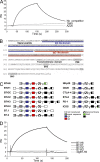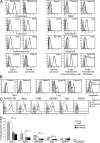The B7 family member B7-H6 is a tumor cell ligand for the activating natural killer cell receptor NKp30 in humans
- PMID: 19528259
- PMCID: PMC2715080
- DOI: 10.1084/jem.20090681
The B7 family member B7-H6 is a tumor cell ligand for the activating natural killer cell receptor NKp30 in humans
Abstract
Cancer development is often associated with the lack of specific and efficient recognition of tumor cells by the immune system. Natural killer (NK) cells are lymphocytes of the innate immune system that participate in the elimination of tumors. We report the identification of a tumor cell surface molecule that binds NKp30, a human receptor which triggers antitumor NK cell cytotoxicity and cytokine secretion. This previously unannotated gene belongs to the B7 family and, hence, was designated B7-H6. B7-H6 triggers NKp30-mediated activation of human NK cells. B7-H6 was not detected in normal human tissues but was expressed on human tumor cells, emphasizing that the expression of stress-induced self-molecules associated with cell transformation serves as a mode of cell recognition in innate immunity.
Figures




References
-
- Arnon T.I., Achdout H., Levi O., Markel G., Saleh N., Katz G., Gazit R., Gonen-Gross T., Hanna J., Nahari E., et al. 2005. Inhibition of the NKp30 activating receptor by pp65 of human cytomegalovirus.Nat. Immunol. 6:515–523 - PubMed
-
- Bottino C., Castriconi R., Moretta L., Moretta A. 2005. Cellular ligands of activating NK receptors.Trends Immunol. 26:221–226 - PubMed
-
- Castriconi R., Dondero A., Augugliaro R., Cantoni C., Carnemolla B., Sementa A.R., Negri F., Conte R., Corrias M.V., Moretta L., et al. 2004. Identification of 4Ig-B7-H3 as a neuroblastoma-associated molecule that exerts a protective role from an NK cell-mediated lysis.Proc. Natl. Acad. Sci. USA. 101:12640–12645 - PMC - PubMed
Publication types
MeSH terms
Substances
LinkOut - more resources
Full Text Sources
Other Literature Sources
Molecular Biology Databases

